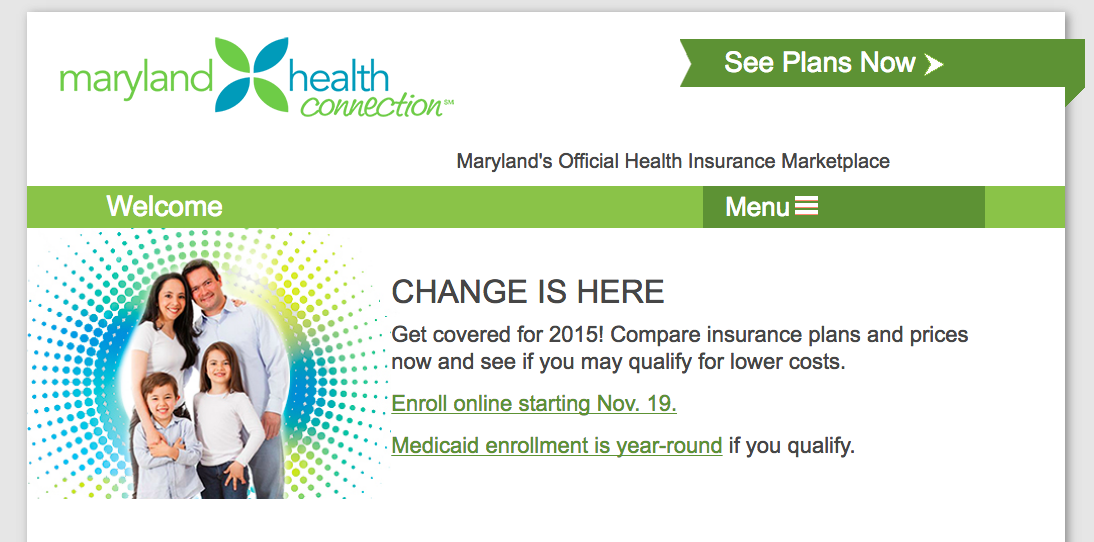The new version of Maryland’s state-run health exchange is live and looking for new enrollees. After a “window shopping” period last week, MarylandHealthConnection.gov will be fully accessible for signups on Wednesday, Nov. 19.
The website, which serves as the primary portal for Maryland users to sign up for coverage under the Affordable Care Act, will be closely watched. For one thing, it represents the Free State’s version of the political lightning rod known as Obamacare. As if that’s not enough cause for scrutiny, it didn’t work so well last time.
On October 1, 2013, the site crashed within minutes of launching. In the ensuing months, the exchange hobbled along, and state officials decided to send some consumers to the federal exchange portal at HealthCare.gov. In the end, the state canned its $193 million contract with Noridian Healthcare Solutions, and scrapped the website.
With new contractors, Baltimore’s Deliotte Consulting and Columbia-based Optum-QSSI, as well as a new website, the state — and the public — is looking for a better experience this time around that will attract more users.
We reached out to the Maryland Health Connection to see what has changed. Here are five differences that the marketing and outreach director Andrew Ratner highlighted:
- It Has a New Platform: For the new website, Maryland used a platform that saw success for the state of Connecticut. With even the feds’ version, HealthCare.gov, limping out of the gate, Connecticut was one of the few successes in 2013’s initial exchange rollout. As a result, the man who ran the Connecticut exchange is now running HealthCare.gov, and states like Maryland are looking to use their success as a model.
- It’s Incremental: According to Ratner, state officials have “performed months of extensive testing in advance of go-live to make sure that Connecticut’s technology aligns with Maryland’s system and meets the needs of consumers.” After the testing period, the site was opened for “window shopping” last week, meaning customers could peruse their options, but couldn’t sign up for a plan. As of Friday, 26,000 people had already compared prices before the site went live, according to Ratner. The launch is further staggered this week. The state’s call center opened on Sunday, navigators and case workers will help clients sign up on Monday and Tuesday this week, and the site will be opened to the general public on Wednesday. This means the system won’t be inundated all at once.
- It’s Anonymous: One of the site’s new features is anonymous browsing. That allows consumers to browse their options for coverage without having to pony up any personal information. Last year, healthcare shoppers had to enter personal data — including Social Security numbers — as soon as they logged in. That led to frozen screens and bottlenecks within the exchange servers. This year, they’ll only have to provide personal data after they decide on a plan.
- It’s More Specific: The new website provides more information about specific plans. Beyond just the premium, enrollees can see information about cost-sharing, and even get access to the cheapest plans in some classifications. Once they sign up, enrollees will also be able to receive notices in the mail and online.
- It’s Automated: The new website also features upgraded back-end technology, which is designed to ensure sure applications will actually go through. According to Ratner, the new system uses a Commercial Off The Shelf (COTS) rules engine to determine applicants’ eligibility for subsidies, and their options. “This rules engine is the same for both the self-service public portal and the caseworker portal, providing consistent eligibility outcomes to all users,” Ratner said. Once consumers navigate the enrollment process, their information will be automatically sent to insurance carriers. That’s a difference from last year, when the back-end often failed to match policies with providers. According to Ratner, the data will be securely sent, following federal protocol.
Overall, “Maryland’s incremental roll out strategy, along with anonymous browsing, has given consumers more time to fully explore their options so they can make informed decisions about the health care coverage that is best for themselves and their families,” Ratner said.
We shall soon see.







